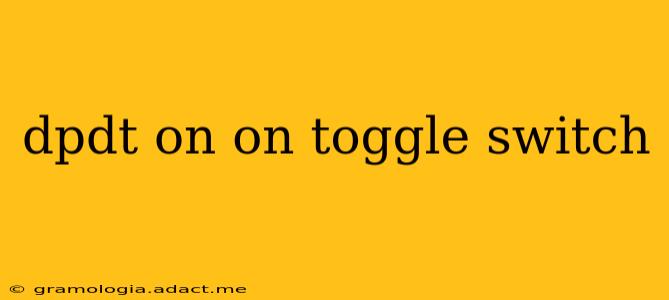Double-Pole, Double-Throw (DPDT) on-on toggle switches are essential components in various electrical and electronic applications. Understanding their functionality, applications, and specifications is crucial for anyone working with circuits. This guide will delve into the intricacies of DPDT on-on toggle switches, addressing common questions and providing a comprehensive overview.
What is a DPDT On-On Toggle Switch?
A DPDT on-on toggle switch is a type of electromechanical switch that simultaneously controls two independent circuits. The "double-pole" refers to the two independent circuits it controls, while "double-throw" signifies that each pole can be connected to either of two separate positions. The "on-on" designation indicates that both positions connect the circuits; there's no "off" position. This means when you flip the switch, it doesn't break the connection; it simply changes which of the two output terminals each pole is connected to.
Think of it like a three-way light switch, but for two separate circuits instead of just controlling a single circuit to two different locations. Instead of just turning a light on or off, a DPDT on-on switch allows you to switch between two distinct circuit configurations.
How Does a DPDT On-On Toggle Switch Work?
The switch's internal mechanism uses a central lever connected to two sets of contacts. When the lever is in one position, a specific set of contacts is closed, connecting the poles to one set of terminals. Flipping the lever to the other position breaks the initial connections and closes a different set of contacts, connecting the poles to a second set of terminals. This switching action occurs instantaneously, making it suitable for various applications requiring rapid circuit changes.
What are the Applications of DPDT On-On Toggle Switches?
DPDT on-on toggle switches find widespread use in diverse applications, including:
- Electronics Projects: Ideal for switching between different power sources, selecting input signals, or controlling multiple circuits simultaneously. Think of applications like switching between different amplifier configurations, or selecting between different signal sources in audio equipment.
- Automotive Applications: Used in various modifications and custom installations. For example, selecting between different sets of speakers, or routing power to additional components.
- Robotics: They can be used to control the direction of motors, select different operating modes or change sensor inputs.
- Lighting Control: While less common than in simpler on/off applications, they can be used in complex lighting setups requiring more than simple on/off control.
What are the Different Types of DPDT On-On Toggle Switches?
DPDT on-on toggle switches come in various sizes, ratings, and configurations. Key differences include:
- Current Rating: This specifies the maximum current the switch can handle safely. Choose a switch with a current rating exceeding the current drawn by the circuits it will control.
- Voltage Rating: This indicates the maximum voltage the switch can safely handle. Again, this must exceed the voltage of the circuits being controlled.
- Mounting Type: They may be designed for panel mounting, PCB mounting, or other configurations.
- Actuator Type: The lever can be different shapes and sizes depending on the need.
Selecting the correct switch based on these factors is crucial to ensure safe and reliable operation.
How to Wire a DPDT On-On Toggle Switch?
Wiring a DPDT on-on toggle switch requires understanding its terminal configuration. The terminals are usually labeled clearly (often with numbers or letters). Consult the datasheet of your specific switch to confirm the terminal arrangement. Proper wiring is essential to ensure the switch functions correctly and safely. Improper wiring can lead to short circuits or damage to connected components. Always refer to a schematic diagram before wiring.
What is the Difference Between a DPDT On-On and a DPDT On-Off-On Switch?
A key difference lies in the "off" position. A DPDT on-on switch always connects the poles to either set of terminals. A DPDT on-off-on switch includes a central "off" position where both sets of contacts are open, breaking the circuits completely. This makes the on-off-on switch useful when you need to fully disconnect circuits, whereas the on-on switch is for switching between circuits, not for turning them on or off.
Where Can I Buy DPDT On-On Toggle Switches?
DPDT on-on toggle switches are readily available from various electronics suppliers both online and in physical stores. Many online retailers specialize in electronic components and offer a wide selection of switches with varying specifications.
This comprehensive guide provides a detailed understanding of DPDT on-on toggle switches, addressing various aspects from functionality to applications and selection. Remember to always prioritize safety and consult relevant datasheets when working with electrical components.
